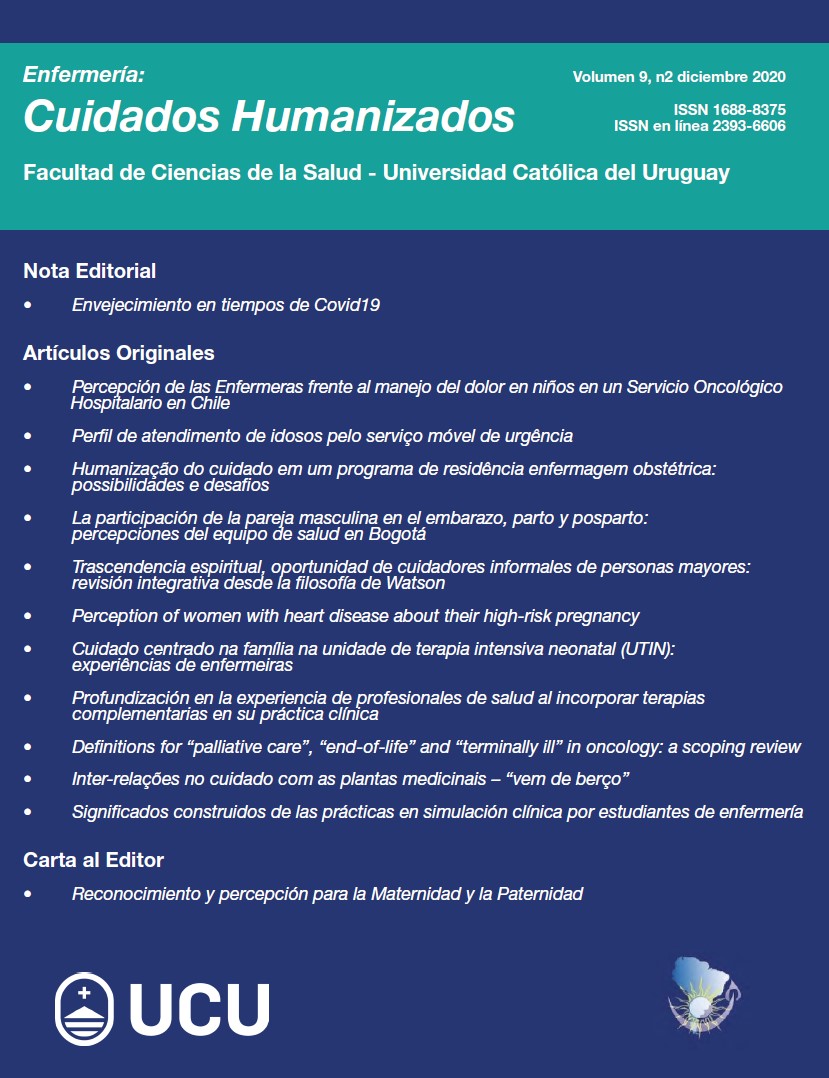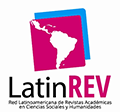Constructed meanings of clinical simulation practices by nursing students
DOI:
https://doi.org/10.22235/ech.v9i2.1931Keywords:
Simulation, Nursing Education, Patient Safety, LearningAbstract
Objective: To describe the meanings that nursing students have built from clinical simulation experience to meet their learning needs. Methodology: The descriptive qualitative study from a hermeneutic paradigm. The design corresponds to an instrumental case study. A focus group and in-depth interviews were applied to 5th year students of the nursing career of Universidad Mayor Temuco, Chile, 2015. Data reduction was done from Atlas Ti software, version 7.0. The transcription of verbal data was developed from Jefferson transcription convention, which allowed the development of codification processes and analysis of narratives. Results: 4 categories emerged: Characteristics of clinical simulation, training expectations of clinical simulation, mobilized competencies and the importance of simulation for clinical practice. Within the observed results, students recognize that clinical simulation provides a safe and risk-free environment, they can integrate what they have learned in theory, into practice, without fear of causing harm to patients, being able to make mistakes, therefore,achieving meaningful learning. In addition, it allows the development of competencies such as teamwork, effective communication, problem solving, stress management and leadership. All this improves the confidence and safety of the student when facing real patients, promoting the delivery of quality nursing care, safeguarding the safety of users. Conclusion: Students value clinical simulation from a technical and personal perspective as a learning methodology that facilitates integration between theory and practice, promoting patient safety, self-confidence and security in the student.
Downloads
References
Stokes, L. G., & Kost, G. C. Teaching in the clinical setting. Teaching in Nursing E-Book: A Guide for Faculty [Internet] Elsevier, 4ª Ed. 2013 [Citado en septiembre 2020]; 592 (311 – 331). Disponible en: https://books.google.cl/books?hl=es&lr=&id=IeBOAQAAQBAJ&oi=fnd&pg=PA311&dq=Teaching+in+the+clinical+setting+stokes&ots#v
Kardong-Edgren, S., Adamson, K. & Fitzgerald, C. A review of currently published evaluation instruments for human patient simulation. Clinical Simulation in Nursing [Internet] 2010 [Citado en septiembre 2020]; 6 (25-35). Disponible en: https://www.nursingsimulation.org/article/S1876-1399(09)00528-3/fulltext.
Cioffi, J. Clinical simulations: Development and validation. Nurse Education Today [Internet] 2001. [Citado en septiembre 2020]; 21 (477 – 486). Disponible en: https://www.sciencedirect.com/science/article/pii/S0260691701905842?via%3Dihub
Gantt, L.T. & Webb-Corbett, R. Using simulation to teach patient safety behaviors in undergraduate nursing education. Journal of Nursing Education [Internet] 2009. [Citado en septiembre 2020]; 49 (48-51). Disponible en: https://www.researchgate.net/publication/26877581_Using_Simulation_to_Teach_Patient_Safety_Behaviors_in_Undergraduate_Nursing_Education/download
Okuda Y., Bryson E., De María S., Jacobson L., Quinones J. & Shen B et Al. The utility of simulation in medical education: what is the evidence? Mt Sinai J Med. [Internet] 2009. [Citado septiembre 2020]; 76 (330-343). Disponible en: https://www.ncbi.nlm.nih.gov/pubmed/19642147
Grady, J.L., Hobbins, B. Headlines from the NLN: How can state boards of nursing encourage curricular reform? Nursing Education Perspectives. [Internet] 2009. [Citado septiembre 2020]; 1 (59-61). Disponible en: https://www.ncbi.nlm.nih.gov/pubmed/19331042
Howard, V., Englert, N., Kameg, K., & Perozzi, K. Integration of simulation across the undergraduate curriculum: Student and faculty perspectives. Clinical Simulation in Nursing. [Internet] 2011. [Citado septiembre 2020]; 7 (1- 10). Disponible en: https://www.sciencedirect.com/science/article/pii/S1876139909005507?via%3Dihub
Corvetto, M., Bravo, M., Montaña, R., Utili, F., Escudero, E. Boza, C. et Al. Simulación en educación médica: una sinopsis. Revista Médica de Chile. [Internet] 2013. [Citado septiembre 2020]; 141 (70-79). Disponible en: https://scielo.conicyt.cl/scielo.php?script=sci_arttext&pid=S0034-98872013000100010
Maran N., Glavin R. Low- to high-fidelity simulation - a continuum of medical education? Med. Educ. [Internet] 2003. [Citado septiembre 2020]; 37 (22-28). Disponible en: https://pdfs.semanticscholar.org/69d3/7fb36bec43135b2b56ab420bb32f87f2ccbe.pdf
Baillie, L., Curzio, J. Students’ and facilitators’ perceptions of simulation in practice learning. Nursing Education in Practic. [Internet] 2009. [Citado en septiembre 2020]; 9 (297-306). Disponible en: https://www.sciencedirect.com/science/article/pii/S1471595308000966?via%3Dihub
Blum, C. A., Borglund, S., Parcells, D. High-fidelity nursing simulation: Impact on student self-confidence and clinical competence. International Journal of Nursing Education Scholarship. [Internet] 2010. [Citado septiembre 2020]; 7 (1-14). Disponible en: https://www.scirp.org/(S(lz5mqp453edsnp55rrgjct55))/reference/ReferencesPapers.aspx?ReferenceID=1642143
Moule P., Wilford, A., Sales, R., Lockyer, L. Student experiences and mentor views of the use of simulation for learning. Nurse Education Today. [Internet] 2008. [Citado septiembre 2020]; 28 (790-797). Disponible en: https://www.sciencedirect.com/science/article/pii/S0260691708000373?via%3Dihub
Traynor, M., Gallagher, A., Martin, L., Smyth, S. From novice to expert: Simulators to enhance practical skill. British Journal of Nursing [Internet] 2010. [Citado septiembre 2020]; 19 (1422-1426). Disponible en: http://eds.b.ebscohost.com/eds/pdfviewer/pdfviewer?vid=0&sid=ad13b6b6-6762-49d2-aa9a-0642aa46800a%40pdc-v-sessmgr01
Ward-Smith, P. The effect of simulation learning as a quality initiative. Urologic Nursing. [Internet] 2008. [Citado septiembre 2020]; 28 (471-473). Disponible en: https://www.suna.org/download/members/unjarticles/2008/08dec/471.pdf
Decker, S., Sportsman, S., Puetz, L., & Billings, L. The evolution of simulation and its contribution to competency. The Journal of Continuing Education in Nursing [Internet] 2008. [Citado en septiembre 2020]; 39 (74-80). Disponible en: http://www.jcenonline.com/view.asp?rID=26233.
Flo, J., Flaathen, E. & Fagerström L. Simulation as a learning method in nursing education. A case study of students’ learning experiences during use of computer-driven patient simulators in preclinical studies. Journal of Nursing Education and Practice [Internet] 2013. [Citado en septiembre 2020]; 8 (138 – 148). Disponible en: https://openarchive.usn.no/usn-xmlui/bitstream/handle/11250/2373828/Flaathen2015Students.pdf?sequence=1
Flick, U. Introducción a la investigación cualitativa. (2ª ed.). Madrid, España: Morata. 2007. (15 – 27).
Lincoln, Y.S. & Guba, E.G. Naturalistic inquiry. Newbury Park, CA: Sage. 1985 (75-121)
Ministerio de Salud. Ley 19.966 de régimen de garantías explícitas en salud. [Internet] 2004. [Citado en septiembre 2020]. Disponible en:
http://www.bibliotecaminsal.cl/wp/wp-content/uploads/2016/03/11.pdf
Ruiz S. Simulación clínica y su utilidad en la mejora de la seguridad de los pacientes. Repositorio Universidad Cantabria, España. [Internet] 2012. [Citado en septiembre 2020]. Disponible en: https://repositorio.unican.es/xmlui/bitstream/handle/10902/901/RuizCozS.pdf?sequence=1
Downloads
Published
How to Cite
Issue
Section
License
Copyright (c) 2020 Enfermería: Cuidados Humanizados

This work is licensed under a Creative Commons Attribution 4.0 International License.

















